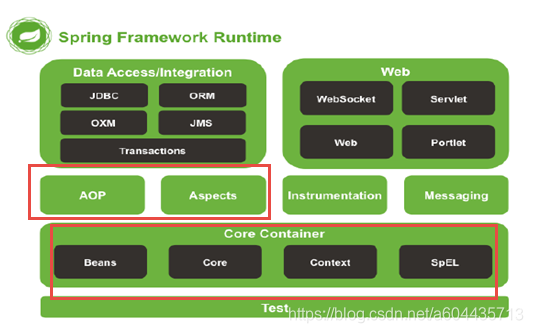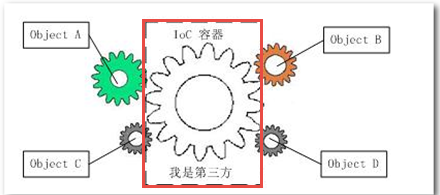spring介绍
Spring的出现是为了取代EJB(Enterprise JavaBean)的臃肿、低效、脱离现实的缺点。
Spring致力于J2EE应用的各层(表现层、业务层、持久层)的解决方案,Spring是企业应用开发的“一站式”选择。
定义:
Spring是分层的JavaSE/EE应用一站式的轻量级开源框架(官网: http://spring.io/ ),以Ioc(Inverse of control)控制反转和Aop(Aspect Oriented Programming)面向切面编程为核心。
轻量级:针对EJB来说,使用方便。
一站式:spring针对各各层(表现层、业务层、持久层)提出解决方案。
表现层:springmvc(spring自己的mvc框架),提供和其它web框架整合方案。
业务层:spring基于aop(面向切面编程)思想进行事务控制。
持久层:spring自己提供JdbcTemplate,提供和其它持久层框架整合的方案。
spring核心 :Ioc(控制反转)和aop(面向切面编程)。
重点是:IOC,spring要管理各各层的bean。

什么是IOC
不使用ioc,代码中创建一个对象直接操作接口实现类,并没有面向接口开发。
面向接口开发:调用接口的方法,只面向接口而不面向接口实现类,因为一个接口可能有多个实现类。
没有面向接口开发的问题:调用接口的类和接口实现类之间存在直接耦合。
解决:
将调用接口的类和接口实现类要解耦合。
可以通过将创建接口实现类对象的工作交给工厂来作。

对象只与工厂耦合,对象之间没有耦合。
什么是IOC:
IoC (Inverse of Control)即控制反转。是指将原来程序中自己创建实现类对象的控制权反转到IOC容器中。只需要通过IOC获了对象的实例,将IOC当成一个黑盒子、工厂。
IOC入门
spring提供ioc容器,对 bean进行实例化。使用bean时候从容器中取。
IOC控制反转,将对象的创建权反转到了spring容器中。
加入spring的jar
下载spring开发包,导入jar包到工程
官网:http://spring.io/
下载地址:http://repo.springsource.org/libs-release-local/org/springframework/spring
下载版本: Spring4.2.4
加入IOC基础的jar包:
导入IOC核心容器jar包
•spring-beans-4.2.4.RELEASE.jar
•spring-context-4.2.4.RELEASE.jar
•spring-core-4.2.4.RELEASE.jar
•spring-expression-4.2.4.RELEASE.jar
spring使用JCL日志体系(commons-logging-1.2.jar)
commons-logging:相当 于原来的slf4j,只有日志接口
还需要加入日志实现:log4j

配置applicationContext.xml
spring的ioc容器的配置文件:applicationContext.xml(默认名称)
配置schema约束:
http://www.springframework.org/schema/beans/spring-beans.xsd
当然也可以在线安装,我这里使用的是本地安装
本地安装下载:https://download.csdn.net/download/a604435713/10758980

配置bean
1、编写好接口及接口实现类
2、需要在spring的容器的配置文件中配置spring要管理的bean。

获取bean实例
@Test
public void test1() {
// 创建spring容器的实例
ApplicationContext applicationContext = new ClassPathXmlApplicationContext("spring/applicationContext.xml");
// 通过容器实例对象获取bean实例
// 通过 bean的名称来获取
CustomerDao customerDao = (CustomerDao) applicationContext.getBean("customerDao");
System.out.println(customerDao);
CustomerService customerService = (CustomerService) applicationContext.getBean("customerService");
System.out.println(customerService);
}
spring对bean进行实例化方法
spring要对applicationContext.xml中配置的bean进行实例化。
包括:通过无参构造器实例化、通过有参构造器实例化、通过静态工厂方法和自动拆装箱
<!-- 测试spring对bean的实例化方法 -->
<!-- 默认通过无参构造器 -->
<bean id="customer1" class="cn.itcast.crm.domain.CstCustomer"></bean>
<!-- 通过有参构造器
构造器:public CstCustomer(Long custId,String custName)
-->
<bean id="customer2" class="cn.itcast.crm.domain.CstCustomer">
<!-- index:参数位置,第一个参数位置为0
value:参数值type:参数类型
-->
<constructor-arg index="0" value="101" type="java.lang.Long"/>
<constructor-arg index="1" value="牛牛" type="java.lang.String"/>
</bean>
<!-- 了解,通过静态工厂方法获取bean的实例
class:配置工厂类的路径
factory-method:调用工厂方法,获取对象
-->
<bean id="customer3" class="cn.itcast.crm.domain.CustomerFactory" factory-method="getCustomer"></bean>

ApplicationContext
ApplicationContext理解为spring容器的上下文,通过上下文操作容器中bean。
ClassPathXmlApplicationContext:加载classpath下的配置文件创建一个容器实例
FileSystemXmlApplicationContext:加载文件系统中任意目录 下的配置文件,创建一个容器实例
//加载多个配置文件
// ApplicationContext applicationContext = new ClassPathXmlApplicationContext(new String[]{"bean1.xml","bean2.xml"});
//通过统配符号加载
// ApplicationContext applicationContext = new ClassPathXmlApplicationContext("classpath:bean*.xml");
ApplicationContext applicationContext = new ClassPathXmlApplicationContext(new String[]{"bean1.xml","classpath:bean*.xml"});
DI
DI的概念
控制反转,哪些对象被反转,获得依赖对象的过程被反转了。
action:调用service,action依赖service,在action中所依赖的service创建被反转到spring容器。
service:依赖dao,依赖的dao创建被反转到spring容器
依赖注入(Dependency Injection)”。所谓依赖注入,就是由IOC容器在运行期间,动态地将对象的依赖关系注入到对象的属性中。
service:依赖dao,如何实现依赖注入?
1、spring要管理service(前提)
2、spring要管理dao(前提)
总结前提:依赖方(service)、被依赖方(dao)都需要被spring管理
3、根据依赖关系,service依赖dao,将dao实例注入至service的属性中。
底层原理:spring根据配置文件中配置依赖关系,首先获取被依赖的对象dao实例,调用service对象中set方法将dao实例设置(注入)到service属性。
DI测试
让spring将service依赖的dao注入。
1、在spring的容器中配置dao和service

2、配置依赖关系,service依赖dao

小结Ioc和Di的区别
ioc:控制反转,将对象的创建权反转到ioc容器。
DI:依赖注入,将对象所依赖的对象注入到对象的属性中。
就是IOC的具体 实现方法。
1、IOC就是一个容器
2、IOC容器中包括spring管理的所有bean。
3、IOC容器负责对bean进行实例化
4、IOC容器对bean进行实例化时候,检查有哪些依赖的属性,将依赖的属性注入到实例化的bean的属性中。
要实现依赖注入,需要spring管理依赖方和被依赖方(spring要对依赖方和被依赖方实例化)。
依赖注入方法
通过有参构造器注入属性值

通过 set方法注入(常用!!!)

测试set方法注入支持属性类型:

<!-- 测试set方法依赖注入的属性类型 -->
<bean id="queryVo" class="cn.itcast.crm.pojo.QueryVo">
<!-- 基本类型 -->
<property name="page" value="1"></property>
<property name="username" value="大牛"></property>
<!-- pojo属性 -->
<property name="customer" ref="customer1"></property>
<!-- list List<String> -->
<property name="listString">
<list>
<value>小牛</value>
<value>小牛</value>
</list>
</property>
<!-- list List<CstCustomer> -->
<property name="customerList">
<list>
<ref bean="customer3"/>
<ref bean="customer3"/>
</list>
</property>
<!-- map -->
<property name="map">
<map>
<entry key="101" value="小牛"></entry>
<entry key="102" value="大牛"></entry>
</map>
</property>
<!-- properties -->
<property name="properties">
<props>
<prop key="101" >小牛</prop>
<prop key="102" >大牛</prop>
</props>
</property>
</bean>
p命名空间和spEL表达式注入方式

总结:
spring:是一个轻量级的框架,提供一站式解决方案。
spring的核心模块:IOC和AOP。
IOC:控制反转
DI:依赖注入,IOC实现方法。
spring要管理bean,需要对bean进行实例化,根据bean所依赖的对象,将依赖对象实例化自动注入到bean的属性。
先实例化再注入。
实例化方法:三种,构造器(有参和无参)、静态工厂方法。
注入方法:有参构造器注入属性值,set方法注入(常用)、p命名空间注入、spEL表达式注入。





















 7036
7036











 被折叠的 条评论
为什么被折叠?
被折叠的 条评论
为什么被折叠?








